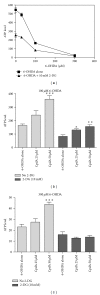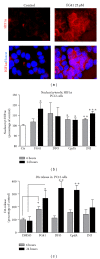Competitive HIF Prolyl Hydroxylase Inhibitors Show Protection against Oxidative Stress by a Mechanism Partially Dependent on Glycolysis
- PMID: 25006572
- PMCID: PMC4061615
- DOI: 10.1155/2013/598587
Competitive HIF Prolyl Hydroxylase Inhibitors Show Protection against Oxidative Stress by a Mechanism Partially Dependent on Glycolysis
Abstract
The hypoxia inducible factor 1 (HIF-1) is a central transcription factor involved in the cellular and molecular adaptation to hypoxia and low glucose supply. The level of HIF-1 is to a large degree regulated by the HIF prolyl hydroxylase enzymes (HPHs) belonging to the Fe(II) and 2-oxoglutarate-dependent dioxygenase superfamily. In the present study, we compared competitive and noncompetitive HPH-inhibitor compounds in two different cell types (SH-SY5Y and PC12). Although the competitive HPH-inhibitor compounds were found to be pharmacologically more potent than the non-competitive compounds at inhibiting HPH2 and HPH1, this was not translated into the cellular effects of the compounds, where the non-competitive inhibitors were actually more potent than the competitive in stabilizing and translocatingHIF1 α to the nucleus (quantified with Cellomics ArrayScan technology). This could be explained by the high cellular concentrations of the cofactor 2-oxoglutarate (2-OG) as the competitive inhibitors act by binding to the 2-OG site of the HPH enzymes. Both competitive and non-competitive HPH inhibitors protected the cells against 6-OHDA induced oxidative stress. In addition, the protective effect of a specific HPH inhibitor was partially preserved when the cells were serum starved and exposed to 2-deoxyglucose, an inhibitor of glycolysis, indicating that other processes than restoring energy supply could be important for the HIF-mediated cytoprotection.
Figures






Similar articles
-
Endogenous 2-oxoglutarate levels impact potencies of competitive HIF prolyl hydroxylase inhibitors.Pharmacol Res. 2011 Sep;64(3):268-73. doi: 10.1016/j.phrs.2011.03.017. Epub 2011 Apr 8. Pharmacol Res. 2011. PMID: 21504793
-
An oxygen molecular sensor, the HIF prolyl 4-hydroxylase, in the marine protist Perkinsus olseni.Protist. 2008 Jul;159(3):355-68. doi: 10.1016/j.protis.2008.03.002. Epub 2008 Jun 9. Protist. 2008. PMID: 18539525
-
Nonhypoxic pharmacological stabilization of Hypoxia Inducible Factor 1α: Effects on dopaminergic differentiation of human neural stem cells.Eur J Neurosci. 2019 Feb;49(4):497-509. doi: 10.1111/ejn.14284. Epub 2018 Dec 8. Eur J Neurosci. 2019. PMID: 30471165
-
Hydroxylation of hypoxia-inducible transcription factors and chemical compounds targeting the HIF-alpha hydroxylases.Curr Med Chem. 2007;14(17):1853-62. doi: 10.2174/092986707781058850. Curr Med Chem. 2007. PMID: 17627521 Review.
-
Cellular oxygen sensing need in CNS function: physiological and pathological implications.J Exp Biol. 2004 Aug;207(Pt 18):3171-88. doi: 10.1242/jeb.01075. J Exp Biol. 2004. PMID: 15299039 Review.
Cited by
-
A possible role of microglia-derived nitric oxide by lipopolysaccharide in activation of astroglial pentose-phosphate pathway via the Keap1/Nrf2 system.J Neuroinflammation. 2016 May 4;13(1):99. doi: 10.1186/s12974-016-0564-0. J Neuroinflammation. 2016. PMID: 27143001 Free PMC article.
-
Differential susceptibility of PC12 and BRL cells and the regulatory role of HIF-1α signaling pathway in response to acute methylmercury exposure under normoxia.Toxicol Lett. 2020 Oct 1;331:82-91. doi: 10.1016/j.toxlet.2020.05.023. Epub 2020 May 24. Toxicol Lett. 2020. PMID: 32461003 Free PMC article.
-
Hypoxia Signaling in Parkinson's Disease: There Is Use in Asking "What HIF?".Biology (Basel). 2021 Jul 29;10(8):723. doi: 10.3390/biology10080723. Biology (Basel). 2021. PMID: 34439955 Free PMC article. Review.
-
Up-regulation of HIF-1α in refractory sudden sensorineural hearing loss.Acta Otorhinolaryngol Ital. 2024 Oct;44(5):333-341. doi: 10.14639/0392-100X-N3017. Acta Otorhinolaryngol Ital. 2024. PMID: 39526770 Free PMC article.
References
-
- Kaelin WG, Jr., Ratcliffe PJ. Oxygen sensing by metazoans: the central role of the HIF hydroxylase pathway. Molecular Cell. 2008;30(4):393–402. - PubMed
-
- Epstein ACR, Gleadle JM, McNeill LA, et al. C. elegans EGL-9 and mammalian homologs define a family of dioxygenases that regulate HIF by prolyl hydroxylation. Cell. 2001;107(1):43–54. - PubMed
-
- Sridharan V, Guichard J, Bailey RM, Kasiganesan H, Beeson C, Wright GL. The prolyl hydroxylase oxygen-sensing pathway is cytoprotective and allows maintenance of mitochondrial membrane potential during metabolic inhibition. American Journal of Physiology—Cell Physiology. 2007;292(2):C719–C728. - PubMed
LinkOut - more resources
Full Text Sources
Other Literature Sources
Miscellaneous
